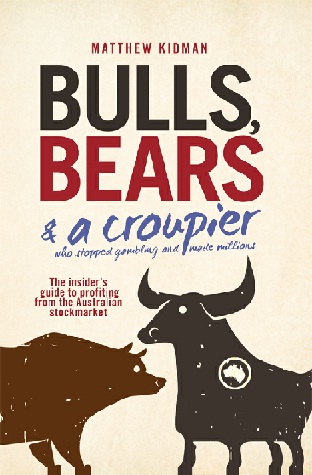Bulls, Bears & a croupier
The text below is an extract from recent book by former Chief Executive Officer and Portfolio Manager of Wilson Asset Management, Matthew Kidman. The book is titled:
BULLS, BEARS & a Croupier who stopped gambling and made millions – The insider’s guide to profiting from the Australian stockmarket
Enter the historians
In my desperation to get some clear answers about the way forward, I stumbled across two market historians, a rare breed in Australia. At about that time two market historians, Craig Scheef and Andrew McCauley, visited our offices within days of each other. Craig was a former professional fund manager who had left Sydney for the calmer environs of the mid north coast of New South Wales. After a two-year break he had started investing again and was happy to discuss his views with a select group of people. Andrew, a veteran stockbroker, worked just down the road in Macquarie Street. Both men had discovered, like me, that the best answers to the future tend to lie in what has happened in the past. Initially, both men were negative, but come the start of 2009 they simultaneously started thumping the table about buying the market, which they said was going to reverse sharply and drive higher at a rapid pace. I thought these guys were mad.
McCauley’s argument was based on his extensive study of quarterly performance of the Australian market. He said the local market had never notched up seven quarterly declines in a row and the March 2009 quarter was the sixth one in succession. He reasoned that unless history was about to be made, the market would bottom and start to rally. To me this was not overly convincing, given that I had supposedly seen history being made several times in 2008.
Scheef came at the problem from a totally different direction. To the outside world, he would be considered a market technician through his extensive study of charts and the use of time series based on multiples of 30 days to gauge human behaviour. To me, though, he is a market historian, and understanding history is a fabulous way to understand more fully how people react in varying circumstances.
Scheef became passionate about the market ending its dive in February 2009 and would say that to anyone who would listen. History tells us both men were correct, and in March 2009 the market turned and started to head higher. As with most aspects of Australian life, the sharemarket’s history is virtually ignored, and few or no records kept. The study of history is a powerfully instructive force that many people could do well to indulge in. It took me the best part of a decade to realise this.
A third person worth mentioning at this time is Credit Suisse analyst Atul Lele. While not a pure historian, Lele has proven to be accurate with his calls, which are based upon global liquidity factors and his own fear ratio. In other words he has been able to conjure up a financial ratio that effectively measures excessive fear and excessive optimism. In early 2009 he also believed the fear and liquidity ratios were all pointing towards a rally. His behavioural approach to markets may be scoffed at by many fundamentalists, but from my point of view I would prefer accurate predictions rather than an approved textbook view.
Scheef ’s and McCauley’s correct market calls got me intensely interested in market behaviour and market history. In particular I thought it should be compulsory to study the secular bull and bear markets over the last 100 years, tempting to work out how long they lasted and if there were any repeating features. So far my research, from late 2007 to mid 2011, has been far more enlightening than virtually any other method of understanding the market, giving me a better idea of what is happening now than the hapless predictions of many highly paid market strategists, who seem to be six months behind what is actually happening. If you understand which way the market is heading you can then knuckle down to the task of picking the stocks that will perform in that environment.
I would like to now look at three secular bear markets — one in Australia and two in the United States. I believe the behavioural patterns exhibited in these periods reveal a great deal of what is going on in 2011. While some people will argue this is too small a sample size to come to any decisive conclusions, I would counter with the fact the two US bear markets cover 40 years from a total of about 82 years. While the Australian secular bear market accounts for eight of past 24 years.
I also believe it is folly to discuss the current secular bear market with the one currently running in Japan, which has been in progress for 21 years. The Japanese market is 75 per cent below its peak of 1990. The Japanese market and culture are substantially different from those in the United States and Australia…..

